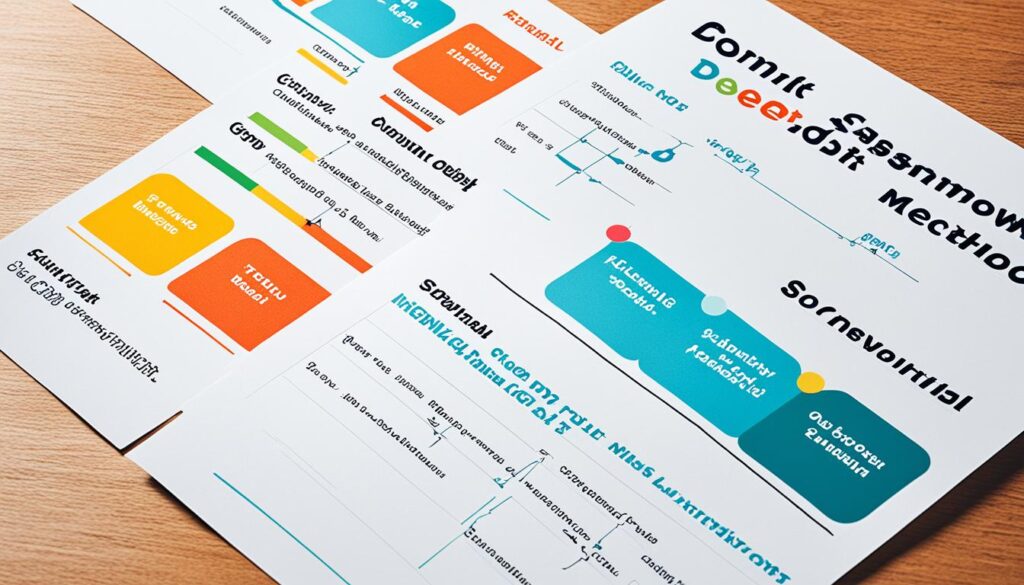The snowball debt method is a popular strategy for clearing debt that can provide several advantages. Unlike other repayment methods, the snowball method focuses on paying off smaller debts first, which can help keep you motivated and on track. While it may not save you as much in interest as other strategies, it offers unique benefits that make it an attractive option for many individuals.
Key Takeaways:
- The snowball debt method involves starting with the smallest debts and working your way up, providing a sense of progress and quick wins.
- By focusing on one debt at a time, the snowball method simplifies the repayment process and makes it easier to manage.
- The snowball method may not save as much in interest compared to other strategies, but it can be a highly motivating approach.
- Consider your financial goals and circumstances when deciding on a debt repayment method, and weigh the pros and cons of the snowball method.
- Remember, paying off debt can have a positive impact on your credit score by lowering your credit utilization ratio.
How the Debt Snowball Method Works
The debt snowball method is a popular approach to paying off debt that can provide numerous advantages. This method involves organizing your debts in order of their balances, from smallest to largest. While it may seem counterintuitive to prioritize smaller debts over those with higher interest rates, the debt snowball method focuses on the psychological benefits of quick wins and progress.
Here’s how the debt snowball method works:
- List your debts in order of their balances, starting with the smallest.
- Make minimum payments on all your debts.
- Allocate any extra money toward the smallest debt.
- Once the smallest debt is paid off, move on to the next smallest debt.
- Continue this process until all your debts are paid in full.
The key principle of the debt snowball method is to focus on one debt at a time, regardless of interest rates. By paying off smaller debts first, you experience a sense of accomplishment and momentum, which can help motivate you to tackle larger debts. This approach simplifies the repayment process and provides a clear roadmap for eliminating your debts.
By adhering to the debt snowball method, you’ll gradually gain financial freedom and peace of mind as you make consistent progress toward becoming debt-free.
See the diagram below for a visual representation of how the debt snowball method works:
The Debt Snowball Method in Action
Let’s consider an example to better understand how the debt snowball method can be implemented:
| Debt | Balance |
|---|---|
| Credit Card 1 | $1,000 |
| Medical Bill | $2,500 |
| Personal Loan | $5,000 |
| Student Loan | $10,000 |
In this scenario, you would focus on paying off Credit Card 1 first, as it has the smallest balance. Once that debt is cleared, you would move on to the Medical Bill, then the Personal Loan, and finally the Student Loan.
By following the debt snowball method, you’ll experience the satisfaction of eliminating debts one by one while building momentum and motivation along the way.
Pros of the Debt Snowball Method
The debt snowball method offers several advantages for individuals looking to eliminate their debt. Here are the key benefits of using the snowball method to reduce your debt:
- Motivation and sense of accomplishment: By starting with smaller debts and gradually working your way up to larger ones, the snowball method provides quick wins. Paying off smaller debts first can boost your motivation and give you a sense of accomplishment, keeping you motivated and committed to paying off your debts.
- Simplicity: Unlike other debt repayment strategies that involve analyzing interest rates and complex calculations, the snowball method is easy to follow. It doesn’t require comparing interest rates or making complex calculations. By focusing on one debt at a time, you can simplify the repayment process and avoid feeling overwhelmed.
- Sense of progress: The snowball method allows you to see tangible progress as each debt is eliminated. By focusing on one debt at a time, you can experience a sense of progress and track your journey towards becoming debt-free. This can provide a great sense of satisfaction and motivation to keep going.
Using the debt snowball method can bring these advantages and make your debt elimination journey more manageable and rewarding. Keep in mind that the right debt repayment strategy depends on your personal financial goals and circumstances.

Cons of the Debt Snowball Method
The debt snowball method has its benefits, but it’s important to consider the drawbacks before choosing this debt repayment strategy. While the snowball method offers perks for debt management, there are certain factors that may not align with everyone’s financial goals and circumstances.
- The snowball method may not save you the maximum amount of interest compared to other strategies. By focusing on balances rather than interest rates, you may end up paying more in interest over time. It’s essential to analyze the long-term financial impact and potential savings before committing to this method.
- Another point to consider is that paying off smaller balances first may take longer to eliminate your total debt compared to strategies that prioritize high-interest debts. This means that it may take more time to end up becoming completely debt-free.
When deciding on a debt repayment method, it’s crucial to weigh the pros and cons. Assess your specific financial goals, evaluate the amount of debt you have, and consider the interest rates associated with each debt. This way, you can make an informed decision that aligns with your unique circumstances.
Debt Snowball Method vs. Debt Avalanche
The debt snowball method is just one of several debt repayment strategies. Another popular strategy is the debt avalanche method, which focuses on paying off debts with the highest interest rates first. While the snowball method may not be the most cost-effective in terms of saving on interest, it offers its unique advantages.
“The snowball method may be more effective for some individuals due to its emphasis on motivation and quick wins.”
The debt snowball method provides tangible motivation by focusing on paying off smaller debts first, giving you a sense of accomplishment and progress. This approach can help you stay motivated and committed to your debt repayment journey. Ultimately, the decision between the snowball method and the debt avalanche method depends on your financial priorities and personal preferences.
Comparison of Debt Snowball and Debt Avalanche Methods
| Debt Repayment Method | Focus | Advantages | Disadvantages |
|---|---|---|---|
| Debt Snowball | Smallest balances first |
|
|
| Debt Avalanche | Highest interest rates first |
|
|
Ultimately, the choice between the debt snowball and debt avalanche methods depends on your financial goals, preferences, and individual circumstances. Consider the advantages and disadvantages of each method and choose the one that best aligns with your needs for effective and manageable debt repayment.
Debt Snowball vs. Debt Avalanche
When it comes to debt repayment strategies, the debt snowball method is just one of several options to consider. Another popular strategy is the debt avalanche method, which focuses on paying off debts with the highest interest rates first. While the debt avalanche method may save you more money in overall interest, the snowball method offers its own unique advantages.
The snowball method is especially effective for individuals who value motivation and quick wins in their debt elimination journey. By starting with the smallest debts and gradually working your way up to larger ones, the snowball method provides a sense of accomplishment as you pay off each debt. This can help you stay motivated and committed to your repayment plan.
Unlike the debt avalanche method, the snowball method does not prioritize interest rates. Instead, it emphasizes the psychological benefits of paying off smaller balances first. This approach can simplify the repayment process, making it easier to manage and stay on track.
Ultimately, the choice between the debt snowball and debt avalanche methods depends on your personal preferences and financial goals. While the debt avalanche method may save you more money in the long run, the snowball method offers debt clearing advantages like motivation and a sense of progress. Consider your priorities and choose the strategy that aligns best with your needs.

Debt Snowball vs. Debt Avalanche: A Comparison
| Debt Snowball Method | Debt Avalanche Method |
|---|---|
| Emphasizes motivation and quick wins by paying off smaller debts first | Focuses on paying off debts with the highest interest rates first |
| Provides a sense of accomplishment as each debt is eliminated | Offers potential savings in overall interest |
| Simplifies the repayment process by focusing on one debt at a time | Requires ongoing calculations and comparisons of interest rates |
| May take longer to pay off the total debt compared to the debt avalanche method | May save more money in the long run by targeting high-interest debts |
What Is Debt Consolidation?
Debt consolidation refers to taking out a new loan or credit to pay off multiple existing debts. This can be done through a debt consolidation loan or by transferring balances to a new credit card with a lower interest rate. Debt consolidation can help simplify your repayment process by combining multiple debts into one monthly payment and potentially lowering your overall interest rate. It’s important to carefully consider the terms of any debt consolidation option and ensure it aligns with your financial goals and circumstances.
Does Paying Off Debt Hurt Your Credit Score?
Paying off debt can actually have a positive impact on your credit score. One of the factors that affects your credit score is your credit utilization ratio, which is the amount of debt you have compared to your available credit. By paying off debt, you lower your credit utilization ratio, which can improve your credit score.
“Lowering your credit utilization ratio by paying off debt can demonstrate responsible financial behavior and improve your creditworthiness.”
However, it’s important to note that closing accounts after paying them off can have a temporary negative impact on your credit score. It’s generally a good idea to keep older accounts open to maintain a longer credit history, which can work in your favor.
The Effect of Debt Payment on Credit Score
When you pay off debt, especially high balances, it indicates responsible financial behavior to lenders and credit agencies. This reflects positively on your credit report and can ultimately improve your credit score. As your credit utilization ratio decreases, your creditworthiness increases, making you a more attractive borrower.
While paying off debt can positively affect your credit score, it’s important to adopt responsible financial habits overall. Timely payments, maintaining low credit utilization, and a good mix of credit types are all factors that contribute to a healthy credit score.
Impact of Closing Accounts
Although paying off debt is beneficial, closing accounts after repayment may have temporary negative effects on your credit score. Closing accounts reduces your available credit, which may increase your credit utilization ratio if you have remaining balances on other accounts.
“By keeping older accounts open, you can maintain a longer credit history and demonstrate your ability to manage credit responsibly.”
It’s advisable to keep older accounts open even after paying them off to maintain a positive credit history and avoid potentially detrimental impacts on your credit score. Regularly review your credit report and monitor your credit utilization ratio to ensure you are on track for a healthy credit profile.
| Pros of Paying Off Debt: | Advantages of Snowball Method: |
|---|---|
| Improved credit score | Motivating and provides a sense of accomplishment |
| Reduced credit utilization ratio | Simplified repayment process |
| Demonstrates responsible financial behavior | Focuses on progress by paying off smaller debts first |
How Can Emergency Funds Help Maximize Wins with the Snowball Debt Method?
Having an emergency fund and snowball debt can work hand in hand to maximize wins in your financial journey. By having a safety net, you can better focus on paying off your debts using the snowball method, where you prioritize and tackle smaller debts first, ultimately leading to greater financial freedom.
Conclusion
The debt snowball method offers several advantages for individuals looking to pay off their debts. One of the main benefits of this method is the motivation it provides. By starting with the smallest debts and paying them off first, you can experience quick wins and a sense of progress, which can keep you motivated throughout your debt elimination journey.
Another advantage of the snowball method is its simplicity. Unlike other debt repayment strategies that require complex calculations and comparisons of interest rates, the snowball method focuses on one debt at a time. This makes it easier to manage and stay on track with your payments, allowing you to simplify your financial life.
While the snowball method may not save you the most money in interest compared to other strategies, it offers the advantage of providing a clear sense of accomplishment. As you see your smaller debts disappear one by one, you’ll feel a sense of achievement and progress that can help you stay committed to your goal of becoming debt-free.
Ultimately, the right debt repayment plan for you will depend on your individual financial situation and goals. If you value motivation, simplicity, and a clear sense of progress, the snowball method may be the perfect choice for you. Consider your priorities and find a strategy that aligns with your needs, so you can successfully eliminate your debts and achieve financial freedom.
FAQ
What are the advantages of the snowball debt clearing method?
The snowball method helps to keep you motivated by providing quick wins and a sense of progress as you pay off smaller debts first. It also simplifies the repayment process by focusing on one debt at a time, making it easier to manage and stay on track.
How does the debt snowball method work?
The debt snowball method involves listing your debts in order of their balances, from smallest to largest. You make minimum payments on all your debts and put any extra money toward the smallest debt. Once the smallest debt is paid off, you move on to the next smallest debt and continue this process until all your debts are paid in full.
What are the pros of the debt snowball method?
The debt snowball method can be motivating and provide a sense of accomplishment as you pay off smaller debts first. It is also easy to follow as it doesn’t require comparing interest rates or complex calculations. By focusing on one debt at a time, you can simplify the repayment process and feel a sense of progress as each debt is eliminated.
What are the cons of the debt snowball method?
One of the main drawbacks of the debt snowball method is that it may not save you the maximum amount of interest compared to other strategies. By focusing on balances rather than interest rates, you may end up paying more in interest over time. Additionally, paying off smaller balances first may take longer to eliminate your total debt compared to strategies that prioritize high-interest debts first.
How does the debt snowball method compare to the debt avalanche method?
The debt snowball method focuses on paying off debts with the smallest balances first, while the debt avalanche method prioritizes paying off debts with the highest interest rates first. The debt avalanche method can save you more money in overall interest, but the snowball method may be more effective for individuals who value motivation and quick wins.
What is debt consolidation?
Debt consolidation refers to taking out a new loan or credit to pay off multiple existing debts. This can help simplify your repayment process by combining multiple debts into one monthly payment and potentially lowering your overall interest rate. It’s important to carefully consider the terms of any debt consolidation option before proceeding.
Does paying off debt hurt your credit score?
Paying off debt can actually have a positive impact on your credit score. By lowering your credit utilization ratio, which is the amount of debt you have compared to your available credit, you can improve your credit score. However, closing accounts after paying them off can have a temporary negative impact, so it’s generally advisable to keep older accounts open to maintain a longer credit history.

